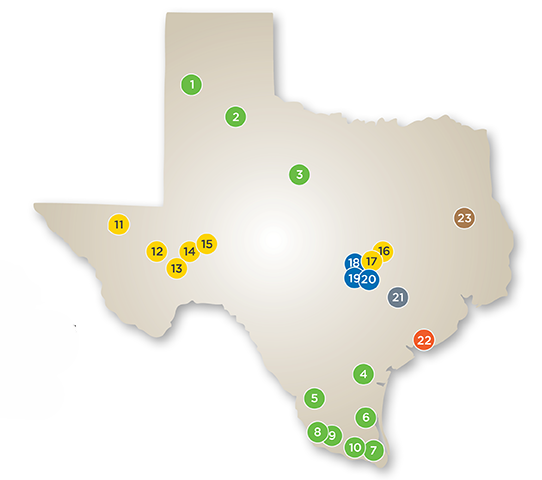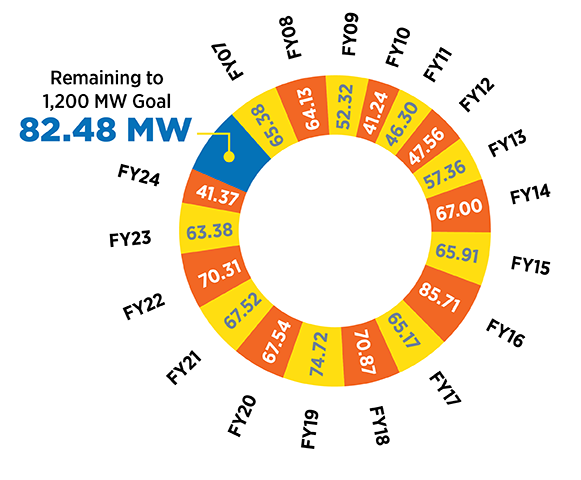Austin Energy By the Numbers
Financial Health, Reliable Service
Customer Driven. Community Focused.
Austin Energy is an enterprise department of the City of Austin. Community-owned since 1895, we provide electric power and retail energy services to the Greater Austin area. The Austin City Council sets rates as well as terms and conditions of service. Austin Energy is part of the Electric Reliability Council of Texas (ERCOT).
Five of the nation’s 20 largest cities own their electric utilities. Only two of these cities — San Antonio and Los Angeles — are larger in population than Austin. In the United States, 2,020 public entities, mostly cities, own their electric utilities.
Approved FY24 Budget in Millions
Total FY24 Employees
Financial
Austin Energy earns no profits and pays no federal income taxes. All revenues benefit the customers of Austin Energy and the residents of the City of Austin. The primary financial benefit to the City of Austin is Austin Energy’s transfer to the General Fund, which is set by policy and allocated by elected City Council members to municipal purposes such as fire and parks.
| September 30, 2024 | September 30, 2023 | |
| Operating Revenues | $1,141 million | $1.094 million |
| Power Supply Revenue | $544 million | $695 million |
| Power Supply Expense | $481 million | $634 million |
| Non-Fuel Expenses | $802 million | $895 million |
| Depreciation Expense | $224 million | $228 million |
| Operating Income (Loss) | $178 million | $32 million |
| Other Revenue (Expense) | $38 million | $54 million |
| General Fund and Building Service Transfer | $115 million | $115 million |
| Net Income/Loss | $25 million |
$29 million |
| Debt Service Coverage | $2.4 million | $2.4 million |
| Debt to Capitol Ratio | 57% | 56% |
Customers
Austin Energy serves residential, commercial, and industrial customers — with the majority falling into the residential category. Customer growth has been strong for many years.
| Customer Class | MWh | Revenue ($) | Customer Count |
| Residential | 4,973,775 | $625,486,557 | 502,316 |
| Commercial | 5,848,098 | $605,499,634 | 54,441 |
| Industrial | 3,384,270 | $216,311,630 | 125 |
| FY Total | 14,206,143 | $1,447,297,820 | 556,882 |
Interactions for the Utility Contact Center
Interactions for Austin 3-1-1
Power Generation
As a municipal utility, Austin Energy owns, operates, and contracts for power generation. It owns natural-gas-fueled power generation facilities as well as biomass, and it owns interests in a coal plant and a nuclear power plant. On the renewable energy side, Austin Energy contracts for thousands of megawatts of wind and solar energy. As with all power producers within ERCOT, all electricity is sold to the ERCOT market at prices set by the competitive market.
Percent of Energy Generated from Austin Energy Assets (MWh) FY23
Texas Generation Map FY24


Carbon-Free Generation
Austin Energy is a leader in adopting innovative technologies, and its goal is to match customers' use with 100% carbon-free generation by 2040, helping the City of Austin reach its goal of becoming a net-zero City.
Carbon-Free Energy as a Percent of Load
Energy Efficiency, Power Storage, and District Energy and Cooling

Customer Energy Solutions originally set a goal to save 1,200 Megawatts (MW) through its programs by 2030. As part of the updated Resource, Generation, and Climate Protection Plan to 2035, that goal has been accelerated to 2027. The focus has also shifted from simply measuring MW reductions to tracking Greenhouse Gas (GHG) emissions reductions across the entire program portfolio.
Austin Energy also invests in other innovative technologies to meet customer energy needs in a changing electric industry, including:
- District Energy and Cooling — Austin Energy operates three central chilling stations for air conditioning use in downtown and other high-density areas. This operation moves peak electric use to non-peak periods to save money.
- Power Storage — In early 2018, Austin Energy installed a major 1.5 MW battery for distribution-level power storage from renewable and other resources.
Transmission and Distribution Infrastructure
Austin Energy owns and operates a high-voltage transmission system to move electricity from power generation facilities to substations for distribution. The transmission system is used by Austin Energy, as well as other utilities within ERCOT, with rates regulated by the Public Utility Commission of Texas. Transmission revenue is earned from utilities within ERCOT, including Austin Energy, and not directly from retail customers.
Austin Energy also manages and improves a distribution system throughout the 437 square mile service area. Our mission is to safely and reliably distribute electricity from our substations to customers’ homes and businesses throughout the Austin area. We work 24/7 to maintain the integrity of our system to meet the needs of our customers.

| Transmission Lines | 633 miles |
| Distribution Lines | 12,270 miles |
| Overhead Transformers | 44,513 |
| Transmission and Distribution Substations | 80 |
| Distribution Poles | 175,927 |
| Pad-mounted and Underground Transformers | 45,083 |
| Transmission Structures | 4,753 |
Reliability
Austin Energy spends millions a year to maintain, replace, and modernize its distribution system. Reliability means customers have the power they need, when they need it. Austin Energy works 24/7 to keep the lights on and the power flowing for Central Texas residents. These numbers do not include major outage events.
